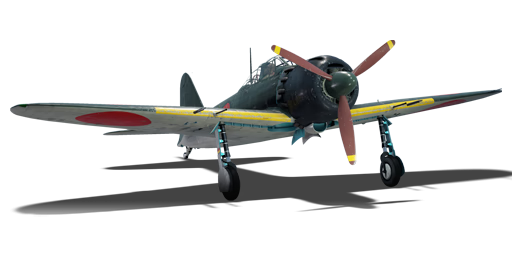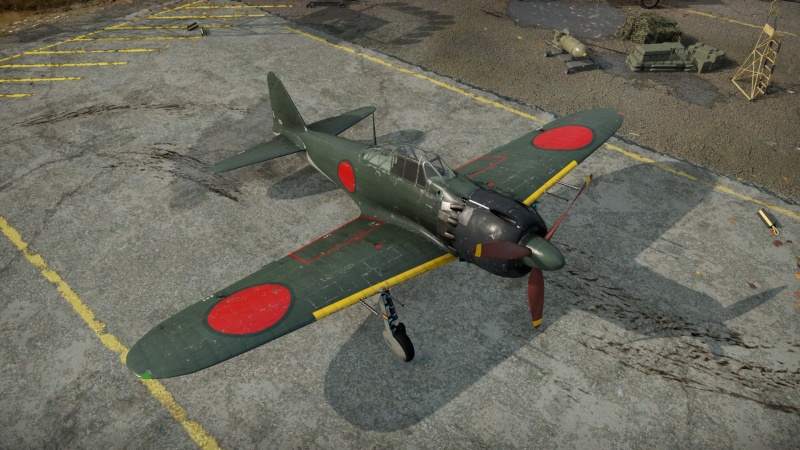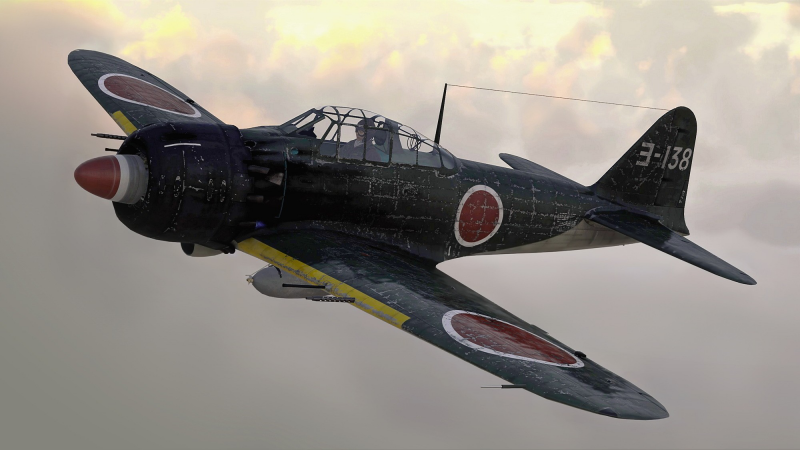Difference between revisions of "A6M6c"
Colok76286 (talk | contribs) (Edits) |
(→General info) (Tag: Visual edit) |
||
| Line 18: | Line 18: | ||
<!-- ''Describe how the aircraft behaves in the air. Speed, manoeuvrability, acceleration and allowable loads - these are the most important characteristics of the vehicle.'' --> | <!-- ''Describe how the aircraft behaves in the air. Speed, manoeuvrability, acceleration and allowable loads - these are the most important characteristics of the vehicle.'' --> | ||
| − | With the new Sakae 31a engine, the A6M6c has a water-methanol injection that makes the WEP | + | With the new Sakae 31a engine, the A6M6c has a water-methanol injection that makes the WEP less vulnerable to overheating. The main flaw of this engine is that once of the water-methanol mixture runs out, the WEP cannot be utilized anymore. The [[B7A2]] also shares this similar flaw with the A6M6c. The WEP lasts for a total of 8 minutes, so it's recommended to conserve it once cruising altitude is reached. Saving a few minutes of WEP for a dogfight can make a difference in combat effectiveness. In total, the WEP setting adds 136 additional horsepower compared to 100% throttle setting. |
| + | |||
| + | The general flight performance of this zero will match the traditional expectations. It is relatively light and nimble, it has an excellent turn rate, and it has great low altitude performance. However, when compared with other late war zeros such as the [[A6M5]] [[A6M5 Ko|Ko]]/[[A6M5 otsu|Otsu]], it feels much heavier and more sluggish. It also has a rather poor rate of climb. It behaves similarly to the [[A6M5 Hei|A6M5 Hei,]] and if the pilot is familiar with the Hei, the pilot can master the A6M6. | ||
{| class="wikitable" style="text-align:center" width="70%" | {| class="wikitable" style="text-align:center" width="70%" | ||
| Line 77: | Line 79: | ||
{{Specs-Avia-Armour}} | {{Specs-Avia-Armour}} | ||
<!-- ''Examine the survivability of the aircraft. Note how vulnerable the structure is and how secure the pilot is, whether the fuel tanks are armoured, etc. Describe the armour, if there is any, and also mention the vulnerability of other critical aircraft systems.'' --> | <!-- ''Examine the survivability of the aircraft. Note how vulnerable the structure is and how secure the pilot is, whether the fuel tanks are armoured, etc. Describe the armour, if there is any, and also mention the vulnerability of other critical aircraft systems.'' --> | ||
| − | + | The A6M6c boasts pilot armor, armored glass, and self sealing fuel tanks, elements missing on earlier models of the A6M. It has increased survivability because of these bonus features. However, it isn't as tough as a P-51, as it is still a zero , and the wings are vulnerable to incendiary rounds. The armor will save you, but you should not rely on it as your primary advantage. | |
=== Modifications and economy === | === Modifications and economy === | ||
| Line 109: | Line 111: | ||
== Usage in battles == | == Usage in battles == | ||
| − | + | ||
| − | + | === Air Realistic Battles === | |
| + | To master the A6M6c in the air, the pilot needs to channel all of the zeros strengths and exploit them against the enemy. The primary goal is to set up a turning engagement and open fire roughly 300 meters from the target in a turn. The zero is vulnerable to energy fighting tactics, so it isn't recommended to boom and zoom, as the zero isn't a fast aircraft. The A6M6c has a poor rate of climb, and it is recommended to side climb slightly and engage targets that are low in energy and altitude. | ||
=== Manual Engine Control === | === Manual Engine Control === | ||
| Line 129: | Line 132: | ||
|} | |} | ||
| − | The Zero's manual engine controls are simple to learn. The propeller pitch should be kept at 95% at all times. The radiators both should be kept between 5 and 15% depending if you are on a hot or cold map. The second supercharger gear should be activated at 3,500 m and above. | + | The Zero's manual engine controls are simple to learn. The propeller pitch should be kept at 95% at all times. The radiators both should be kept between 5 and 15% depending if you are on a hot or cold map. The second supercharger gear should be activated at 3,500 m and above. The Mixture can be kept at 60% percent for all altitudes. |
=== Pros and cons === | === Pros and cons === | ||
| Line 137: | Line 140: | ||
* Powerful armament with good ammo count, the 13 mm MGs are effective | * Powerful armament with good ammo count, the 13 mm MGs are effective | ||
| − | * Retains some of the famous | + | * Retains some of the famous maneuverability of the A6M series, makes for a capable dogfighter |
| − | * Has some | + | * Has some armor, combined with better guns it makes the plane capable for bomber hunting |
* Can carry effective rockets | * Can carry effective rockets | ||
* Stronger WEP than earlier Zeros | * Stronger WEP than earlier Zeros | ||
| + | * Capable of carrier landing and takeoff | ||
'''Cons:''' | '''Cons:''' | ||
| − | * | + | * Heavier than other zeros, does not handle as well |
| − | * | + | * Vulnerable to incendiary rounds |
| − | * Very | + | * Very poor top speed |
| − | * Not | + | * Not potent at high altitude |
| − | * Limited WEP mode | + | * Limited WEP mode. Only 8 minutes of WEP. |
| + | * Rockets are launched two at a time, limiting the amount of targets you can destroy | ||
== History == | == History == | ||
| Line 158: | Line 163: | ||
;Skins | ;Skins | ||
| + | |||
* [https://live.warthunder.com/feed/camouflages/?vehicle=a6m6c Skins and camouflages for the {{PAGENAME}} from live.warthunder.com.] | * [https://live.warthunder.com/feed/camouflages/?vehicle=a6m6c Skins and camouflages for the {{PAGENAME}} from live.warthunder.com.] | ||
| Line 168: | Line 174: | ||
* ''links to approximate analogues of other nations and research trees.'' --> | * ''links to approximate analogues of other nations and research trees.'' --> | ||
''Links to the articles on the War Thunder Wiki that you think will be useful for the reader, for example:'' | ''Links to the articles on the War Thunder Wiki that you think will be useful for the reader, for example:'' | ||
| + | |||
* ''reference to the series of the aircraft;'' | * ''reference to the series of the aircraft;'' | ||
* ''links to approximate analogues of other nations and research trees.'' | * ''links to approximate analogues of other nations and research trees.'' | ||
Revision as of 01:21, 27 August 2021
| This page is about the Japanese fighter A6M6c. For other versions, see A6M (Family). |
Contents
Description
The A6M6c is a premium gift rank IV Japanese fighter with a battle rating of 5.0 (AB/RB) and 4.7 (SB). It was introduced during Update "Red Skies" as a reward for Battle Pass: Season IV, "Fearless Voltigeur".
General info
Flight performance
With the new Sakae 31a engine, the A6M6c has a water-methanol injection that makes the WEP less vulnerable to overheating. The main flaw of this engine is that once of the water-methanol mixture runs out, the WEP cannot be utilized anymore. The B7A2 also shares this similar flaw with the A6M6c. The WEP lasts for a total of 8 minutes, so it's recommended to conserve it once cruising altitude is reached. Saving a few minutes of WEP for a dogfight can make a difference in combat effectiveness. In total, the WEP setting adds 136 additional horsepower compared to 100% throttle setting.
The general flight performance of this zero will match the traditional expectations. It is relatively light and nimble, it has an excellent turn rate, and it has great low altitude performance. However, when compared with other late war zeros such as the A6M5 Ko/Otsu, it feels much heavier and more sluggish. It also has a rather poor rate of climb. It behaves similarly to the A6M5 Hei, and if the pilot is familiar with the Hei, the pilot can master the A6M6.
| Characteristics | Max Speed (km/h at 6,400 m) |
Max altitude (metres) |
Turn time (seconds) |
Rate of climb (metres/second) |
Take-off run (metres) | |||
|---|---|---|---|---|---|---|---|---|
| AB | RB | AB | RB | AB | RB | |||
| Stock | 522 | 506 | 10900 | 20.9 | 21.7 | 7.8 | 7.8 | 350 |
| Upgraded | 566 | 543 | 19.1 | 20.0 | 14.4 | 10.7 | ||
Details
| Features | ||||
|---|---|---|---|---|
| Combat flaps | Take-off flaps | Landing flaps | Air brakes | Arrestor gear |
| ✓ | ✓ | ✓ | X | ✓ |
| Limits | ||||||
|---|---|---|---|---|---|---|
| Wings (km/h) | Gear (km/h) | Flaps (km/h) | Max Static G | |||
| Combat | Take-off | Landing | + | - | ||
| 0 | 300 | 398 | 369 | 220 | ~14 | ~6 |
| Optimal velocities (km/h) | |||
|---|---|---|---|
| Ailerons | Rudder | Elevators | Radiator |
| < 280 | < 420 | < 410 | > 336 |
Survivability and armour
The A6M6c boasts pilot armor, armored glass, and self sealing fuel tanks, elements missing on earlier models of the A6M. It has increased survivability because of these bonus features. However, it isn't as tough as a P-51, as it is still a zero , and the wings are vulnerable to incendiary rounds. The armor will save you, but you should not rely on it as your primary advantage.
Modifications and economy
Armaments
Offensive armament
The A6M6c is armed with:
- 2 x 20 mm Type 99 Model 2 cannons, wing-mounted (125 rpg = 250 total)
- 1 x 13.2 mm Type 3 machine gun, nose-mounted (230 rpg)
- 2 x 13.2 mm Type 3 machine guns, wing-mounted (240 rpg = 480 total)
Suspended armament
The A6M6c can be outfitted with the following ordnance:
- Without load
- 2 x 60 kg Navy Type 97 Number 6 bombs (120 kg total)
- 1 x 250 kg Navy Type Number 25 Model 2 bomb (250 kg total)
- 10 x Type 3 No.1 Mod.28 Mk.1 rockets
- 2 x Type 3 No.6 Mod.27 Mk.1 rockets
Usage in battles
Air Realistic Battles
To master the A6M6c in the air, the pilot needs to channel all of the zeros strengths and exploit them against the enemy. The primary goal is to set up a turning engagement and open fire roughly 300 meters from the target in a turn. The zero is vulnerable to energy fighting tactics, so it isn't recommended to boom and zoom, as the zero isn't a fast aircraft. The A6M6c has a poor rate of climb, and it is recommended to side climb slightly and engage targets that are low in energy and altitude.
Manual Engine Control
| MEC elements | ||||||
|---|---|---|---|---|---|---|
| Mixer | Pitch | Radiator | Supercharger | Turbocharger | ||
| Oil | Water | Type | ||||
| Controllable | Controllable Not auto controlled |
Controllable Not auto controlled |
Controllable Not auto controlled |
Separate | Controllable 2 gears |
Not controllable |
The Zero's manual engine controls are simple to learn. The propeller pitch should be kept at 95% at all times. The radiators both should be kept between 5 and 15% depending if you are on a hot or cold map. The second supercharger gear should be activated at 3,500 m and above. The Mixture can be kept at 60% percent for all altitudes.
Pros and cons
Pros:
- Powerful armament with good ammo count, the 13 mm MGs are effective
- Retains some of the famous maneuverability of the A6M series, makes for a capable dogfighter
- Has some armor, combined with better guns it makes the plane capable for bomber hunting
- Can carry effective rockets
- Stronger WEP than earlier Zeros
- Capable of carrier landing and takeoff
Cons:
- Heavier than other zeros, does not handle as well
- Vulnerable to incendiary rounds
- Very poor top speed
- Not potent at high altitude
- Limited WEP mode. Only 8 minutes of WEP.
- Rockets are launched two at a time, limiting the amount of targets you can destroy
History
Describe the history of the creation and combat usage of the aircraft in more detail than in the introduction. If the historical reference turns out to be too long, take it to a separate article, taking a link to the article about the vehicle and adding a block "/History" (example: https://wiki.warthunder.com/(Vehicle-name)/History) and add a link to it here using the main template. Be sure to reference text and sources by using <ref></ref>, as well as adding them at the end of the article with <references />. This section may also include the vehicle's dev blog entry (if applicable) and the in-game encyclopedia description (under === In-game description ===, also if applicable).
Media
- Skins
- Videos
See also
Links to the articles on the War Thunder Wiki that you think will be useful for the reader, for example:
- reference to the series of the aircraft;
- links to approximate analogues of other nations and research trees.
External links
| Mitsubishi Company (三菱商会) | |
|---|---|
| Fighters | A5M4 · Hagiri's A5M4 |
| A6M2 mod. 11 · A6M2 · A6M3 · A6M3 mod. 22 · A6M3 mod. 22Ko · A6M5 · A6M5 Ko · A6M5 otsu · A6M5 Hei · A6M6c | |
| A7M1 (NK9H) · A7M2 | |
| J2M2 · J2M3 · J2M4 Kai · J2M5 · J2M5 (30 mm) | |
| Hydroplanes | F1M2 |
| Interceptors | Ki-83 · Ki-109 |
| Bombers | G4M1 |
| Ki-21-Ia · Ki-21-I hei · Ki-67-I Ko · Ki-67-I otsu | |
| Jet Fighters | Ki-200 |
| Captured | ▃A6M2 · ␗A6M2 |
| See also | Mitsubishi Heavy Industries, Ltd. (Post-War) |
| Japan fighters | |
|---|---|
| Navy | |
| Carrier-based fighter | |
| A5M | A5M4 · Hagiri's A5M4 |
| A6M | A6M2 mod. 11 · A6M2 · A6M3 · A6M3 mod. 22 · A6M3 mod. 22Ko · A6M5 · A6M5 Ko · A6M5 otsu · A6M5 Hei · A6M6c |
| A7He | A7He1* |
| A7M | A7M1 (NK9H) · A7M2 |
| Land-based Fighter | |
| J2M | J2M2 · J2M3 · J2M4 Kai · J2M5 · J2M5 (30 mm) |
| J6K | J6K1 |
| J7W | J7W1 |
| N1K-J | N1K1-Ja · N1K2-J · N1K2-Ja |
| Fighter seaplane | |
| N1K | N1K1 |
| A6M-N | A6M2-N |
| Army | |
| Ki-10 | Ki-10-I · Ki-10-I C · Ki-10-II · Ki-10-II C |
| Ki-27 | Ki-27 otsu · Ki-27 otsu Tachiarai |
| Ki-43 | Ki-43-I · Ki-43-II · Ki-43-III otsu |
| Ki-44 | Ki-44-I · Ki-44-I 34 · Ki-44-II otsu · Ki-44-II hei |
| Ki-61 | Ki-61-I ko · Ki-61-I otsu · Ki-61-I hei · Tada's Ki-61-I hei · Ki-61-I tei · Ki-61-II Otsu Kai |
| Ki-84 | Ki-84 ko · Ki-84 otsu · Ki-84 hei |
| Ki-87 | Ki-87 |
| Ki-94 | Ki-94-II |
| Ki-100 | Ki-100 · Ki-100-II |
| Other countries | ▅F4U-1A · ▅P-51C-11-NT · ▅Bf 109 E-7 · ▅Fw 190 A-5 |
| *Imported designation of the He 112 (A6M was in development - A7M would take A7 designation after the cancelation of the A7He) | |
| Japan premium aircraft | |
|---|---|
| Fighters | Hagiri's A5M4 · A7He1 · Ki-27 otsu Tachiarai |
| Ki-44-II otsu · ▅Bf 109 E-7 · ▅F4U-1A · Ki-100-II · Ki-44-I 34 | |
| ▅Fw 190 A-5 · A7M1 (NK9H) · Tada's Ki-61-I hei · ▅P-51C-11-NT | |
| J2M4 Kai · A6M5 Ko · A6M6c · J2M5 · Ki-87 · J6K1 | |
| Twin-engine fighters | Ki-96 |
| Jet fighters | F-86F-40 JASDF▅ · T-2 Early · F-4EJ ADTW |
| Strike aircraft | ▄AV-8S |
| Bombers | Ki-21-I hei · Ki-48-II otsu · H8K3 · B7A2 (Homare 23) · ▅B-17E |






